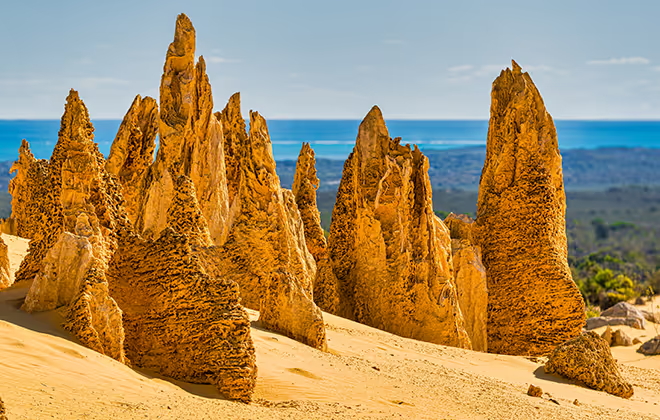Tour destinations
Responsible tourism


The Pinnacles in Nambung National Park near the town of Cervantes is one of the most visited natural tourist attractions in Western Australia, and it’s easy to see why. The astonishing sight of thousands of weathered limestone rock spires rising out of the yellow sandy earth has become one of Australia’s most unique and intriguing landscapes.
The Pinnacles remained unknown to most Australians until 1967 when the area was gazetted as a reserve and later became part of Nambung National Park. For thousands of years, however, it has been a sacred place for Indigenous Nyoongar women who gathered to do ‘women’s business’ – collecting food, giving birth and holding important ceremonies.

Take the first step toward your next adventure—explore our tours or get a free brochure sent to your inbox.
It doesn’t matter what time of year, or what time of day (or night) you visit The Pinnacles Desert, you’ll be greeted with a magical sight. Easily accessed by vehicle or a short walk, The Pinnacles rising up from the sandy earth create an eerie silhouette on the stark desert background.
Some of the formations are narrow, jagged spires while others are smooth and curved. The taller pinnacles reach up to 3.5 metres, while shorter ones resemble small gravestones. The spires date back between 25,000 and 30,000 years, yet the way they came to be, remains a mystery that is still a subject of debate.
What is known is the raw material that formed the limestone originally came from seashells that were broken down into lime-rich sands and carried inland by the winds over thousands of years to form high sand dunes.

.avif)
The mushroom-shaped pinnacles were formed into that shape due to remnants of a calcrete capping. The calcrete is harder than the limestone below and therefore weathers at a slower rate leaving more material at the top of the pinnacle.
Other structures in The Pinnacles Desert have cross-bedding formations, where the angle of the deposited sand changed suddenly due to strong winds, affecting the formation of the limestone.
Visit the eerily spectacular Pinnacles Desert on a Fun Over 50 Holiday to Western Australia.
While visiting the Pinnacles you might meet Western grey kangaroos who graze on the vegetation. Also making their home in the desert are emus, sand goannas, carpet pythons and bobtails while Baudin’s black cockatoo with its distinctive white ear patch and white tail panel can be seen flying overhead.
The Pinnacles Desert abounds with native flora and fauna. Many varieties of wattle and banksia can be found along with quandong, cockies tongue, parrot bush, yellow tailflower, thick-leaved fan flower and banjine.
The best time to visit the Pinnacles is during the cooler months from March to October, which offers more comfortable weather for exploring the site. During Autumn, the temperatures start to cool down after the summer heat, with daytime temperatures ranging from around 20°C to 30°C,making it ideal for outdoor activities like hiking and sightseeing.
This is also outside the peak summer season which means fewer crowds, providing a more serene and enjoyable experience.
Our team is always happy to help if you have any questions about us or our tours. Fill out our form and we will get back to you soon.